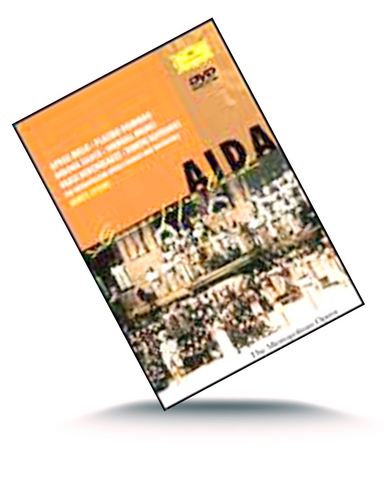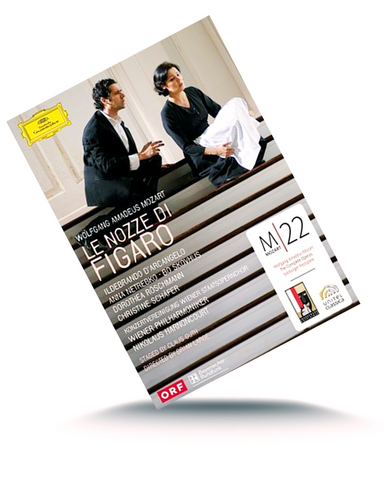A major reason for the particular suitability of opera to the DVD format is the subtitle options it offers. English, French, German, Italian, Spanish and Chinese — these are the languages available on all three of the operas reviewed this month. The inclusion of each work's original language as well as the five translations is significant. This eminently desirable addition is nowadays becoming standard.
LE NOZZE DI FIGARO

Mozart
Salzburg Festival 2006
DGM 073 4245

Claus Guth's innovative production of Le Nozze di Figaro was the talk of last summer's Salzburg Festival and is now out on two DVDs from Deutsche Grammophon. It's simultaneously solemn and frivolous. Nikolaus Harnoncourt conducts the Vienna Philharmonic with some extravagantly slow speeds, and much of the action has the seriousness of an Ibsen drama (a dark effect emphasized by the use of a prominent cello continuo). Other elements, however, prove surprisingly playful.
Most notable of these is the use of two figures to represent Cherubino, one a soprano (Christine Schafer) to do the singing, the other a young man (Uli Kirsch) who weaves his way among the other characters as a symbolic cherub, supposedly representing the pressures they feel that they're under. Thus the Count (excellently sung and acted by Bo Skovhus) gives his Act Three aria Vedro mentr'io sospiro with this somewhat hefty cherub first lodged on his shoulder, then kicking him, dragging him about, and finally ripping off his shirt.
The other key innovation is the assumption that the Count and Susanna are having an affair. As a result, the friendship between Susanna and the Countess becomes hard for the director to handle (in the Canzonetta sull' aria, for instance). In addition, Bartolo starts off in a wheelchair and Don Curzio is presented as being blind. There are other oddities, such as an inexplicable obsession with a dead raven.

The production's basic visual style is early 20th century, with everyone wearing black-and-white costumes, and the set (for all four acts, bar a few numbers at the start of Act Four) the hall of a large house strangely lacking any furniture, with the result that most singers spend a lot of time lying on the floor.
Despite these shortcomings, Ildebrando D'Arcangelo makes an outstanding Figaro, darkly compelling, and Dorothea Roschmann a superbly passionate Countess. Anna Netrebko is a strong and intelligent Susanna — in the bonus section we see her chatting about her role wearing swimwear and sitting by a pool — and there's no weak link among the other soloists. The arias for Marcellina and Basilio that are often cut from Act Four are here included.
This Figaro, part of an initiative to issue new versions of all Mozart's 22 operas, works well whenever its eccentricities don't actually get in the way. It's an example of what are, on the surface, bizarre ideas working with, not against, the spirit of the opera. I've rarely heard as vivid detail as we get from the Vienna Philharmonic, and all in all this is a fresh, unusual but stylish Figaro that finally won me over by its authoritative orchestral playing and frequently superlative singing.

DIE ZAUBERFLOTE
Mozart
Salzburg Festival 1982
JINGO JDV 311056
Opera filmmaker Jean-Pierre Ponnelle didn't only make movies of operas — he also directed stage performances. Taiwan's Jingo has just released the DVD version of his production of Mozart's Die Zauberflote (The Magic Flute), also from the Salzburg Festival with the Vienna Philharmonic, but this time back in 1982. Mounted on a huge stage at the Felsenreitschule, a formerly open-air arena once used for displays of horse-riding, the opera benefits from the broad acting area available, even though this at the same time poses the challenge of how to fill it. The result is a spacious Zauberflote with Ileana Cotrubas as Pamina, Edita Gruberova as the Queen of the Night, and Martti Talvela as Sarastro. Some of the comedy feels dated now but, with a youthful James Levine conducting, this is nonetheless a warm-hearted show and an important collector's item.
AIDA
Verdi
Metropolitan Opera 1988
DGM 073 001-9
Aida from New York's Metropolitan Opera is the least interesting of the three operas. Re-packaged it may be, but this version with Aprile Millo and Placido Domingo dating from 1988 has long been in the record stores in one form or another. Its great strength lies in its sumptuous settings, some of which win roars of approval from the audience. There may not be elephants, but there are certainly horses and hundreds of extras, all appropriate for a work Verdi was commissioned to write for performance in Egypt in 1871 to celebrate the inauguration of the Suez Canal.
VITUS
Original Soundtrack
Teo Gheorghiu, piano
Sony/BMG 82876859022
Lastly Vitus (pronounced "Veetus"), an original sound-track CD of the Swiss film currently showing in Taipei. It tells the story of a musically gifted boy who, despite being able to play the piano to concert soloist standard, wants above all else to take to the air at the controls of his grandfather's private plane. Teo Gheorghiu plays Vitus aged 12 (an even younger actor plays him when he's six) and plays the piano on screen. Classical piano tracks alternate on the CD with versions of the film's theme music (by Mario Beretta). Gheorghiu clearly has genuine talent, but he's not a virtuoso in his own right. Even so, this CD will appeal to filmgoers who also have an interest in classical music.

May 26 to June 1 When the Qing Dynasty first took control over many parts of Taiwan in 1684, it roughly continued the Kingdom of Tungning’s administrative borders (see below), setting up one prefecture and three counties. The actual area of control covered today’s Chiayi, Tainan and Kaohsiung. The administrative center was in Taiwan Prefecture, in today’s Tainan. But as Han settlement expanded and due to rebellions and other international incidents, the administrative units became more complex. By the time Taiwan became a province of the Qing in 1887, there were three prefectures, eleven counties, three subprefectures and one directly-administered prefecture, with

It’s an enormous dome of colorful glass, something between the Sistine Chapel and a Marc Chagall fresco. And yet, it’s just a subway station. Formosa Boulevard is the heart of Kaohsiung’s mass transit system. In metro terms, it’s modest: the only transfer station in a network with just two lines. But it’s a landmark nonetheless: a civic space that serves as much more than a point of transit. On a hot Sunday, the corridors and vast halls are filled with a market selling everything from second-hand clothes to toys and house decorations. It’s just one of the many events the station hosts,

Among Thailand’s Chinese Nationalist Party (KMT) villages, a certain rivalry exists between Arunothai, the largest of these villages, and Mae Salong, which is currently the most prosperous. Historically, the rivalry stems from a split in KMT military factions in the early 1960s, which divided command and opium territories after Chiang Kai-shek (蔣介石) cut off open support in 1961 due to international pressure (see part two, “The KMT opium lords of the Golden Triangle,” on May 20). But today this rivalry manifests as a different kind of split, with Arunothai leading a pro-China faction and Mae Salong staunchly aligned to Taiwan.

Two moves show Taichung Mayor Lu Shiow-yen (盧秀燕) is gunning for Chinese Nationalist Party (KMT) party chair and the 2028 presidential election. Technically, these are not yet “officially” official, but by the rules of Taiwan politics, she is now on the dance floor. Earlier this month Lu confirmed in an interview in Japan’s Nikkei that she was considering running for KMT chair. This is not new news, but according to reports from her camp she previously was still considering the case for and against running. By choosing a respected, international news outlet, she declared it to the world. While the outside world